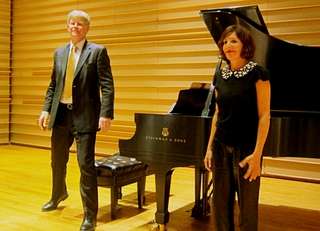|
Back
The Fastidious Brahms New York
Benzaquen Hall, The DiMenna Center for Classical Music
09/10/2013 -
Johannes Brahms: Scherzo in E flat Minor, Opus 4 – Variations on a Theme by Robert Schumann, Opus 23 – Piano Sonata in C Major, Opus 1
Ian Hobson, Claude Edrai Hobson (Pianists) 
I. Hobson, C.E. Hobson (© Coco T. Dog)
George Bernard Shaw once described his joy when encountering music by Johannes Brahms in a concert hall. “It gives me time”, he explained, “to go off into a corner and read through the day’s newspapers.”
Obviously Ian Hobson, that most cultivated English pianist, is no Shavian. (Not even a close Shavian. )The interval between last night and November 14 will have been his opportunity to offer absolutely every Brahms solo and chamber work with piano in 14 Brahms-dedicated recitals with his friends. Enough music, in fact, that old G.B.S. would have had time to read his Fabian literature, as well as Tolstoy and Ibsen (all his favorites) and still had time to take a walk outside and harangue those who didn’t agree with him.
Ian Hobson, obviously, would pay no attention, for as a pianist and conductor, he is far more interested in mastering every work of the 19th Century composers in which he excels. (Not that he avoids composers of his own lifetime. Enescu, Milhaud, Francaix, Lees and John Gardner have been recorded by him to great acclaim.)
Mr. Hobson takes nothing for granted. When he started to play Chopin, he played the entire canon of Chopin. When he essayed Schumann, it was the complete Schumann And with this epic series of Brahms–all of which are listed under http://brahmsseriesnyc.bpt.me–he will have ignored not a single note of the composer.
To Brahms purists, Mr. Hobson was predicted to be a godsend, though he does have to contend with one challenge. The acoustics of Benzequean Hall from my seat in the third row, was almost arid. Mr. Hobson used the pedal sparingly, but if he’d kept his foot pasted on the right pedal, it would have made no difference. Not even the Steinway can give a resonance, a full-bodied voice here. Any mistakes, any blurring (and there were a few minor glitches in the second work) are as apparent as a dune in the Sahara.
On the other hand, Mr. Hobson has a cleanliness which partners well with these sounds. Resembling a Conservative backbencher more than the great artist he is, Mr. Hobson barely lifted his arm, glued his eyes on the keyboard, and performed with a fastidiousness which ranged form the sedate to the severe. In the age of bravura showmanship, Mr. Hobson’s attention to the work at hand was almost disconcerting.
His music-making on this first evening initially reflected his countenance. Brahms had marked this early Scherzo “fiery and quickly”, but this is after a repeated phrase which can be almost gnomic–or in some cases mysterious. Mr. Hobson eschewed the mystery and was rarely fiery. In fact, the tempos, while certainly rapid, were devoid of the Brahms “swing”, the mark of the young genius at work. Yes, the trios, with foretellings of Brahms the symphonist, were beautifully broad, but otherwise, the work was devoid of that playfulness.
The entire series is labeled “Classical Inclinations in a Romantic Age”, and Mr. Hobson evidently takes that classical label literally.
The other youthful work was the Opus 1 Piano Sonata, where Mr. Hobson enjoyed a more spacious palette. He didn’t expand his emotions here, for he has little of the showy virtuoso. And while he could have been a bit more antic in the Scherzo, this Sonata showed more of the inner composer. One imagines that in another concert hall, he would have created the deep round tones and penetration of this piece. Here, one could say that he had distilled the piece to its essence. Like most distillations, though, that does not lead to an emotional valedictory.
The real rarity was a seldom-heard set of variations for four hands on the last theme written by Robert Schumann from his asylum. That theme was (said Schumann from his asylum) transported to him by an angel who wrote it down from Schubert and/or Mendelssohn (though he had actually used it in his Violin Concerto.) I heard it for the first time on YouTube before the concert, and–save for the interesting funeral march as the last of ten variations–it hardly compared to Brahms’ other variations.
Mr. Hobson performed at the lower half of the Steinway, while a longtime partner, Claude Edrai Hobson, took the treble. A few moments were interesting (a repeated Beethoven Fifth Symphony motif in the fourth variation), but as a whole, this was what Mr. Hobson probably is showing in these 14 concerts. New works by this old master, played with distinction, care and a certain degree of elegance.
By the way, the single encore, the second Schumann Opus 28 Romance, even in its simple structure, was given with more zest, even more affection than the preceding Brahms. Perhaps Mr. Hobson didn’t have to fit the Schumann into his box of “Classical Inclinations” and could show more of his own personality.
Harry Rolnick
|